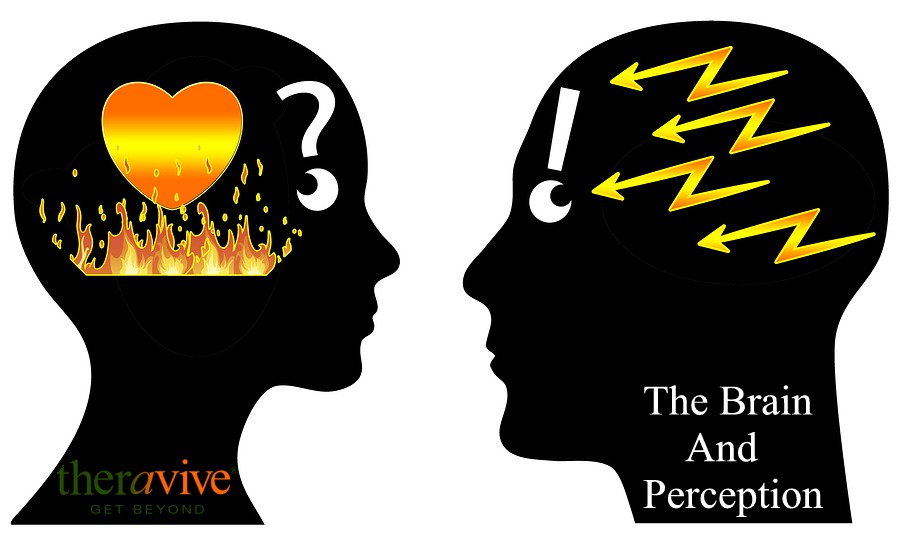
“He’s changed!” “I can’t make her happy!” Statements like these are some of the most common statements that couples make about their lovers. One thing these statements and many more like them have in common is that there is a negative perception of the other. Furthermore, the perception forms a frozen image of one’s partner, and it is viewed as the truth and the whole truth about the other. However, perception is not truth or fact. Rather, by definition, it is one's interpretation of their observation of their partner, and at best is a partial truth. There is a certain deception in perception.
The Progression of Perception
In romantic relationships there is a natural progression of perception. This natural progression of perception can be traced through the early stages of the relationship. The first stage of the relationship is referred to as The Falling in Love Stage or The Romantic Stage. It happens when Cupid shoots his arrow, and the lover comes under the spell of Cupid’s magic potion. This stage is characterized by an overwhelmingly positive perception of the other. Numerous studies in the last 20 years have demonstrated this overwhelmingly positive perception lasts between six months and two years into the relationship and is associated with a natural neural chemical shift in the brain and body that results in a euphoric high.
Somewhere between six months and two years into virtually every romantic relationship there is a shift in one’s perception of the other from the positive of the romantic stage to negative perceptions of one’s lover. In some relationships this shift is gradual and in others it is sudden. The negative perceptions begin to usurp the positive perceptions and ushers in the second stage of the romantic relationship referred to as, The Power Struggle Stage or The Disillusionment Stage. For many, this all too familiar stage is characterized by bewilderment and wondering what has happened. Many are convinced that their lover has changed. Often lovers wonder if they made a big mistake or if they were fooled into believing in their partner. There is often a déjà vu sense accompanied with this experience.
The Unconscious Journey
So, what is actually happening that causes this universal phenomenon of falling in love and falling out of love? The research points to two phenomenon that converge to create these perceptions.
The first has to do with Cupid’s arrow that shoots the lover with a magic potion. The myth as it turns out is not so far fetched. There are numerous neurochemical reactions that are happening in the brain when a person falls in love.
Stephanie Ortigue, Ph.D. assistant professor of psychology and adjunct assistant professor of neurology at Syracuse University studied MRI’s of people who indicated they were in love (Fischetti, January 18, 2011). She discovered unusually high levels of certain neural chemicals and peptides responsible for producing euphoric pleasurable sensations, sexual arousal, and obsessive thinking. At the same time Ortigue discovered unusually low levels of neural chemicals that assist with a reasonable sense of fear, and rational thinking. This combination of neural chemicals is present during the falling in love experience. This chemical cocktail the brain produces is a natural amphetamine. It produces an amphetamine high that greatly influences one's perceptions and decision-making processes.
Most lovers have had the experience that their partner is just the one to make them happy, that they can complete each other sentences, and they know what the other person is thinking. Many lovers have had that euphoric experience that causes their face to light up when their lover comes into the room. Many lovers experience somatic shifts. They feel warm, and their cheeks glow rosy red just to name a couple common reactions. Frequently lovers loose the capacity to focus on normal life functioning such as the loss of focus on their job or their schooling and obsess day and night about their new found love.
Through this process lovers create a perception of the other that exaggerates the positive characteristics and is blind to the negative characteristics of the other. In this process there is also a self-perception that is very similar in character and quality. This self-perception is likewise highly distorted. The net result is an amazing euphoric experience of falling in love and bonding with another person in a very unique way. For many this bonding is very quick and very intense. For others this bonding is more gradual with less intensity. Nevertheless, the romantic stage secures a powerful bond between two people.
However, in the natural course of events the normal human brain cannot maintain this high-level neural chemical imbalance. The natural high wears off somewhere between six months and two years into the relationship. When that happens there is an equal and opposite experience of one's lover and of self. The degree of intensity that happened in the romantic stage is often reflected in the degree of intensity that is experienced in the power struggle stage. To the degree that one romanticizes their perception of their partner and self in the romantic stage will be the degree that one villainizes their partner and victimizes self in the power struggle stage. This is the equal but opposite perception of self and other. It too is experienced as the truth, yet is largely interpretation. It is indeed a deception of perception.
The reason this happens has to do with the second phenomenon--a psychological process that converges with the neural chemical shifts in the brain.
The Mental Image
John Bowlby (2014) was the first to articulate the premise that the quality of "nurture" has a significant impact on a child's relationships in adulthood. Bowlby (2014) coined the term "internal working model of attachment" to describe the process of internalizing the experience and quality of the child/caregiver interactions. The internal working model of attachment is comprised of mental representations of self and other. The internal working model of attachment unconsciously becomes the basis for what intimate relationships are unconsciously expected to look like. The current neuroscience literature overwhelmingly supports the hypothesis that mental models formed early in childhood have a strong impact on adult relationships.
Rick Hansen in Hardwiring Happiness (2013) argued that the brain is hardwired for survival therefore is always expecting the worst. Therefore, while humans consciously look for happiness they unconsciously expect hardship and misery. This is especially true with intimate relationships.
Ed Tronick (2007) added that not only does one create a mental model, but also participates in creating the model scene. Each new relationship carries forward the existing unconscious model scene and slightly alters the scene with the current experiences. Unfortunately experiences that are negative have a much greater impact than those that are positive. Therefore at the unconscious level each new relationship produces more anticipation of fewer fulfillments and less expectation of greater satisfaction. In other words, with each new relationship the expectation for difficulties is magnified and becomes the unconscious expectation of the relationship. This perception is illustrated in the often-repeated expression, “I knew it was too good to be true.”
The mental model that is formed in childhood is one’s perception of their caregivers and of themselves based on one’s interpretation of childhood experiences. The most pleasant and the most painful childhood experiences form the mental model for what normally shows up in the first two stages of adult relationships. These are the unconscious perceptions lovers’ hold. Because the negative experiences are painful they make a more significant impact. These mental models become the basis for what intimate relationships look like, and unconsciously are expected to be. The young adult launching out and looking for the adult intimate relationship unconsciously looks for the familiar and to duplicate the experience of love based on the internal mental model.
Based on the unconscious mental scene, the Romantic stage is an exaggerated replication of the early attachment experience. The experience is one of perfection. The beliefs that one has about their lover are so exaggerated that it is humanly impossible for the lover to live up to those expectations. Therefore, in most romantic relationships the partner is idealized and placed on a pedestal. Inevitably, that partner will fall off the pedestal. For some it is a dramatic sudden crash. In other relationships it is a gradual falling. Nevertheless it happens in virtually all romantic relationships and it happens unconsciously or outside of one’s conscious awareness.
The Road to True Love
The good news is that when lovers recognize that the perceptions of self and their partners are unconscious representations of their dream love, self, and an idealized relationship being experienced as reality they can recreate the relationship of their dreams. When lovers become consciously aware of their perceptions, the origin of those perceptions, and the meaning of those perceptions, they can move toward the third stage of romantic relationship—The True Love Stage. This stage is characterized by greater self-awareness and acceptance of one's partner. It is an experience of relaxed joyfulness, of safety and energized creativity. The true love stage is a passionate place to be.
Through conscious dialogue, mindfulness, and self-awareness lovers can recreate their relationship and in the process of acceptance create a safe place for both partners to find relaxed joyfulness and for the aliveness in each other's arms while growing into their full potential.
______________________________________________________________________________________________________________________
Resources
Fischetti, M. (January 18, 2011). Your Brain in Love. Scientific American. Retrieved from http://www.scientificamerican.com/article/your-brain-in-love-graphsci/
John Bowlby. Retrieved December 18, 2014 from the John Bowlby Wiki: http://en.wikipedia.org/wiki/John_Bowlby
Hanson, R. (2013). Hardwiring Happiness: The New Brain Science of Contentment, Calm and Confidence [Ibook version]. Retrieved from Apple.com.
Tronick, E. (2007). The Neuorbehavioral and Social-Emotional Development of Infants and Children. New York, NY: Norton.
About the Author

Dr. Tony Victor
, D.Min., LCPC The Midwest Relationship Center LLCEach member of The Midwest Relationship Center has a particular specialty. Each therapist is committed to providing the most effective services. Our office manager will listen to your specific situation and recommend the therapist best suited to your particular need.
Office Location:
6 Emerald Terrace Suite 4
Swansea, Illinois
62226
United States
Phone: 618-516-3338
Contact Dr. Tony Victor
Professional Website:
http://www.TheMidwestRelationshipCenter.com